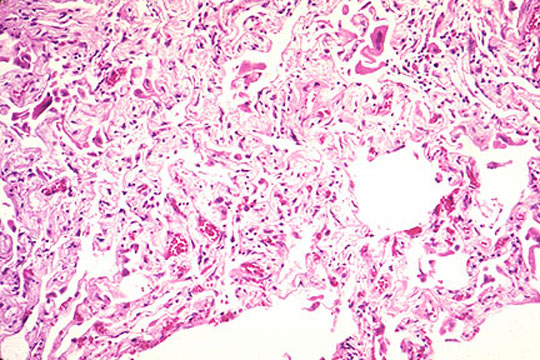Atypical pneumonia is an infection that targets the lower respiratory tract. Atypical pneumonia is similar to regular pneumonia, however with atypical pneumonia you are less likely to be hospitalized. While this infection is contagious, it does take longer to display symptoms compared to the common cold or flu. With that being said atypical pneumonia can affect anyone. Although, you are more at risk of catching this infection if you are over the age of 65, someone who smokes, or you are below the age of 2. In addition, you are more at risk if you are in a typical outbreak area, such as work, school, or college dorms. Some of the symptoms of atypical pneumonia include:
- headache
- low-grade fever
- sore throat
- earache

Atypical pneumonia has a large impact on the on the lungs in the respiratory tract.
| Formal binomial name of microbe: | Mycoplasma pneumoniae |
| Gram stain (gram positive, gram negative or neither): | Gram-negative |
| Is the microbe mobile or immobile? | Mobile |
| Primary habitat? (Where is the organism normally found or prefer to live?) | Attach to the mucosal surfaces in the respiratory tract |
| Can the organism infect humans? | Yes |
| Can the organism infect other species? If so, which ones. | Yes
|
| Documented cases of antimicrobial resistance? | Yes |
| Number of infections per year in the US | 2 million |
| Number of infections per year in the world | Half a billion |

Image of a gram-negative gram stain of Mycoplasma pneumoniae.
Atypical pneumonia can occasionally be referred to as Walking pneumonia, since the two both stem from M. pneumoniae. Typically once a person has been affected with this microbe, it takes roughly 2-6 days before you start to experience any symptoms. While the symptoms for Atypical pneumonia tend to be subtle many people don’t realize they have pneumonia. However, symptoms can intensify from your typical cold to include, clammy/sweaty skin, chest pain, and shortness of breath. Although, the symptoms of Atypical pneumonia depend on the the type of bacteria causing the infection. Other common types of bacteria that cause pneumonia are Chlamydophila pneumoniae and Legionella pneumophila.
Once the symptoms intensify it is best to seek out medical attention. When it comes to diagnosing Atypical pneumonia the doctor will ask the patient a series of questions about their symptoms, followed by a physical where they will check oxygen levels. Sometimes, an x-ray is necessary to make sure it is in fact atypical pneumonia and not another condition. Once diagnosed doctors will prescribe antibiotics to fight off the bacteria and an anti-inflammatory medication to help reduce any fevers or aches and pains. It’s also best to stay hydrated with water and herbal teas and to stay well rested.
Now there are some preventative measures that can be taken to help lower your risk of pneumonia. “Taking steps, such as quitting smoking and eating a healthful diet, can strengthen the immune system. And a stronger immune system is more likely to fight off the pathogens that cause the infections.” (MedicalNewsToday). Another step would be to stay up to date with vaccines, such as pneumonia, flu, and whooping cough to help lower your risk of catching pneumonia. Avoid contact with anyone who has pneumonia. Lastly, always cover your mouth when sneezing or coughing and wash your hands frequently.
News Article #1
Cleveland Clinic says that atypical pneumonia is arises more from Mycoplasma pneumonia than any other bacteria. In fact, they found that 1 out of 10 cases are from the result of M. pneumonia. However, they later mentioned that mostly all cases of atypical pneumonia that result in hospitalization arise from the bacteria Legionella pneumonia.
News Article #2
MedicalNewsToday reports that with atypical pneumonia since the symptoms are so minor many children just feel tired or run down, so they don’t typically complain and just go on with their regular activities. In addition, if a child has asthma sometimes the symptoms confuse parents with asthma flare ups and tend to go unnoticed.
News Article #3
References:
“Pneumonia: Atypical (Walking) Pneumonia”;Cleveland Clinic; https://my.clevelandclinic.org/health/diseases/15744-pneumonia-atypical-walking-pneumonia
“The symptoms of walking pneumonia in children”; MedicalNewsToday; https://www.medicalnewstoday.com/articles/319306.php
“Community-Acquired Pneumonia Among Smokers”; Archivos De Bronconeumologia; https://www.archbronconeumol.org/en-community-acquired-pneumonia-among-smokers-articulo-S1579212914001256